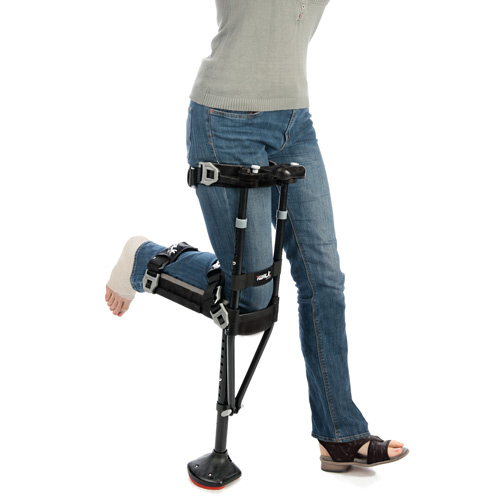Originally Published: August 7, 2015
Day 1 — Research and meeting Dr. Sladek
The morning following my Achilles tendon rupture isn’t too bad. I’m able to work a bit (from home), and begin researching specifics about treatment and recovery options.
Achilles tendon ruptures have two general treatment patterns: operative, and non-operative.
Surgery (operative treatment) vs non-operative treatment
Operative treatment involves general anesthesia, an incision alongside the tendon, and a strong suture that reconnects the separated tendon.
Non-operative treatment means leg immobilization, with the toes pointed down, and allowing the frayed ends of the tendon to reconnect naturally with scar tissue. It appears to be important to do this within the first 48 hours following the injury, before the tendon has had a chance to shrink and pull too far away.
Surgery has been the primary treatment pattern for healthy, younger adults who have a complete Achilles tendon rupture. Anecdotally, it seems that doctors outside the United States (particularly in Europe) will more commonly use non-operative treatment.
Risk of re-rupture
While the achilles tendon is healing, patients are at risk of a re-rupture. An obvious setback, re-rupture means that the patient has to start over in their recovery. Research suggests that the rate of re-rupture is considerably lower for patients who’ve had operative treatment (surgery), under 5%, versus upward of 20% for those who have elected non-operative treatment.
Timing and reason for re-ruptures is all over the place, but from anecdotal evidence, it seems like many occur when patients transition to normal shoes (around the 3-4 month mark), or when patients unexpectedly slip and bear more weight than their healing Achilles tendon is ready for.
Recovery patterns
Recovery is similar for both surgery and non-operative treatment. Most patients start out in a non-weight-bearing fiberglass cast or immobilizing boot, graduate to a walking boot with crutches, eventually discard the crutches, and eventually discard the boot. The timing of these events will be individualized, and at the discretion of a physician.
The non-weight-bearing phase is what concerned me the most. Some physicians like their patients to begin partial weight bearing as soon as possible; others want to keep patients off the leg for two months. As I learned four years ago, being on crutches with limited mobility is an absolute bummer. It’s hard to use the bathroom, challenging to bathe, to do household chores, to do anything.
Treatment for an acute achilles rupture is shifting in the direction of early weight-bearing. Several studies in the last decade have shown that early weight-bearing is not likely to increase the risk of re-rupture in patients (regardless of surgery or non-operative treatment), though also not likely to improve long-term outcomes. The benefit of early weight bearing is mostly social, in the form of a patient feeling better about themselves and their situation.
Meeting Dr. Sladek
My orthopedic surgeon, the experienced Dr. Sladek, performs a quick test to confirm the Achilles tendon rupture, and then advises me to go with surgical repair. I was expecting something more involved, like a referral for an MRI, and a thorough run-through of his approach to recovery, but neither happen and I am sent home with a surgery date for nextTuesday (Day #5).
Before sending me on my way, Dr. Sladek does share his preference for getting patients weight-bearing soon after surgery. He references the literature I have been reading, and his comment provides some hope that I will at least be walking around again within a few weeks.
Ordering things for home-use
After getting home, it’s time to order a few things I came across while researching.
Hands-free crutch
Crutches get the job done, but they will bruise your armpits and it’s tough to carry things while moving around on them.
I know I want an alternative to crutches, but I’m not sure if it should be a knee scooter, or a hands-free crutch.
After reading and considering reviews, I opt for the iWalkFree 2.0, which costs $149.00 on Amazon.com, and a $10.99 upcharge for next-day delivery.
Leg elevator
The simplest way to elevate my bad leg on the bed is to use pillows. I have extra, and they get the job done. However, they don’t provide a deep sense of security in that they will hold my leg in place while I’m asleep.
So I’m also ordering the ProCare leg elevator, a sturdy foam cutout that will securely raise my leg.
Water-resistant cast protector
Though I don’t require it yet, at some point I know I will need to protect my cast from the splish-splash of shower water. The MacGyver approach is to use a trash bag and duct tape, but a $20 cast protector seems like an easier, re-usable solution (provided the seal works).
Shower chair
Purchased from Meijer, the shower chair provides a stable, rubber-footed place to rest while showering. Without this, I would have to awkwardly stand on one leg while showering.
Hand-held shower head
Another purchase from Meijer, the hand-held shower head lets me bring the water’s spray to wherever I need it. The provided cord is five feet long, but I’m going to order a longer cord on Amazon to give myself a little extra reach.
